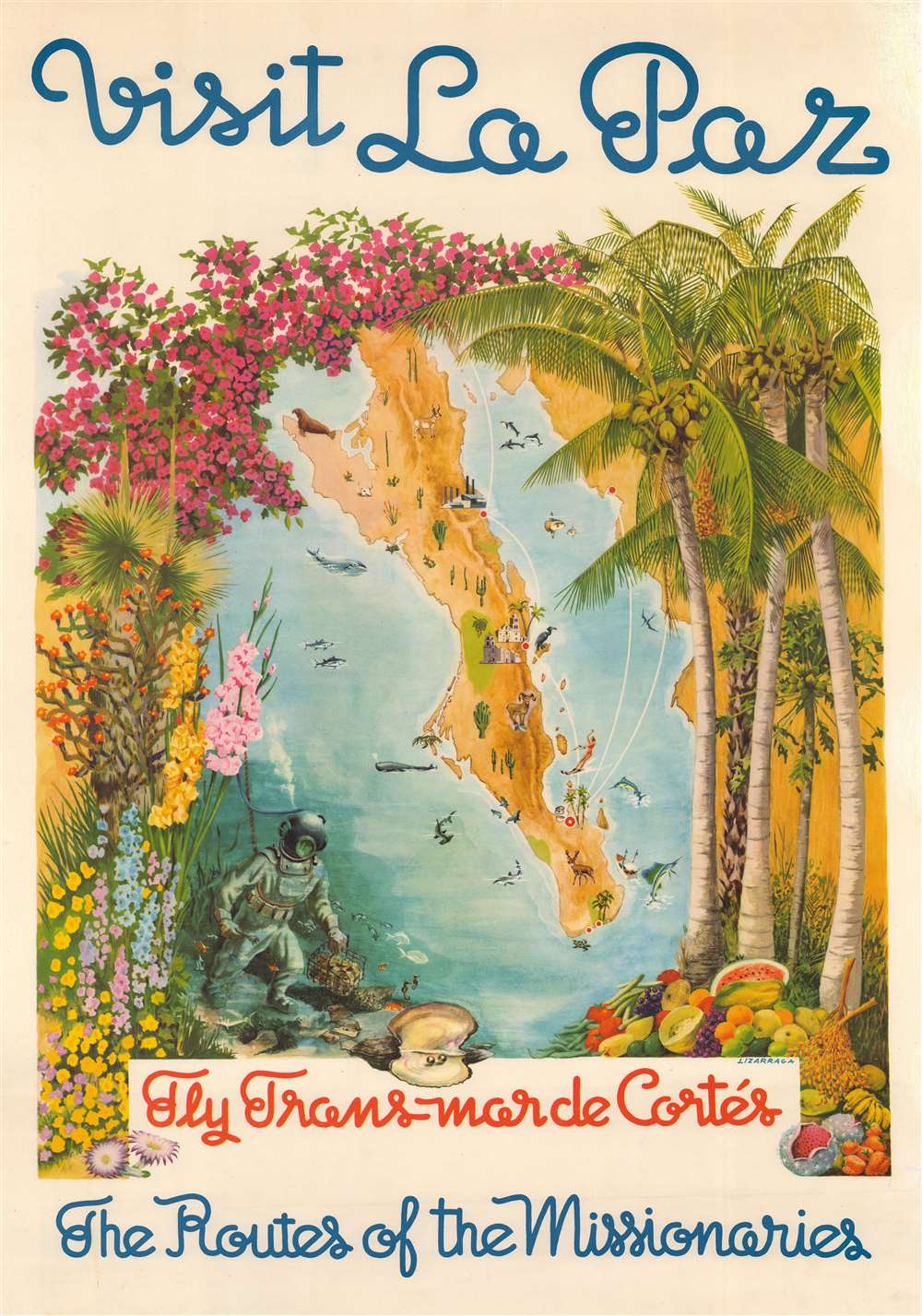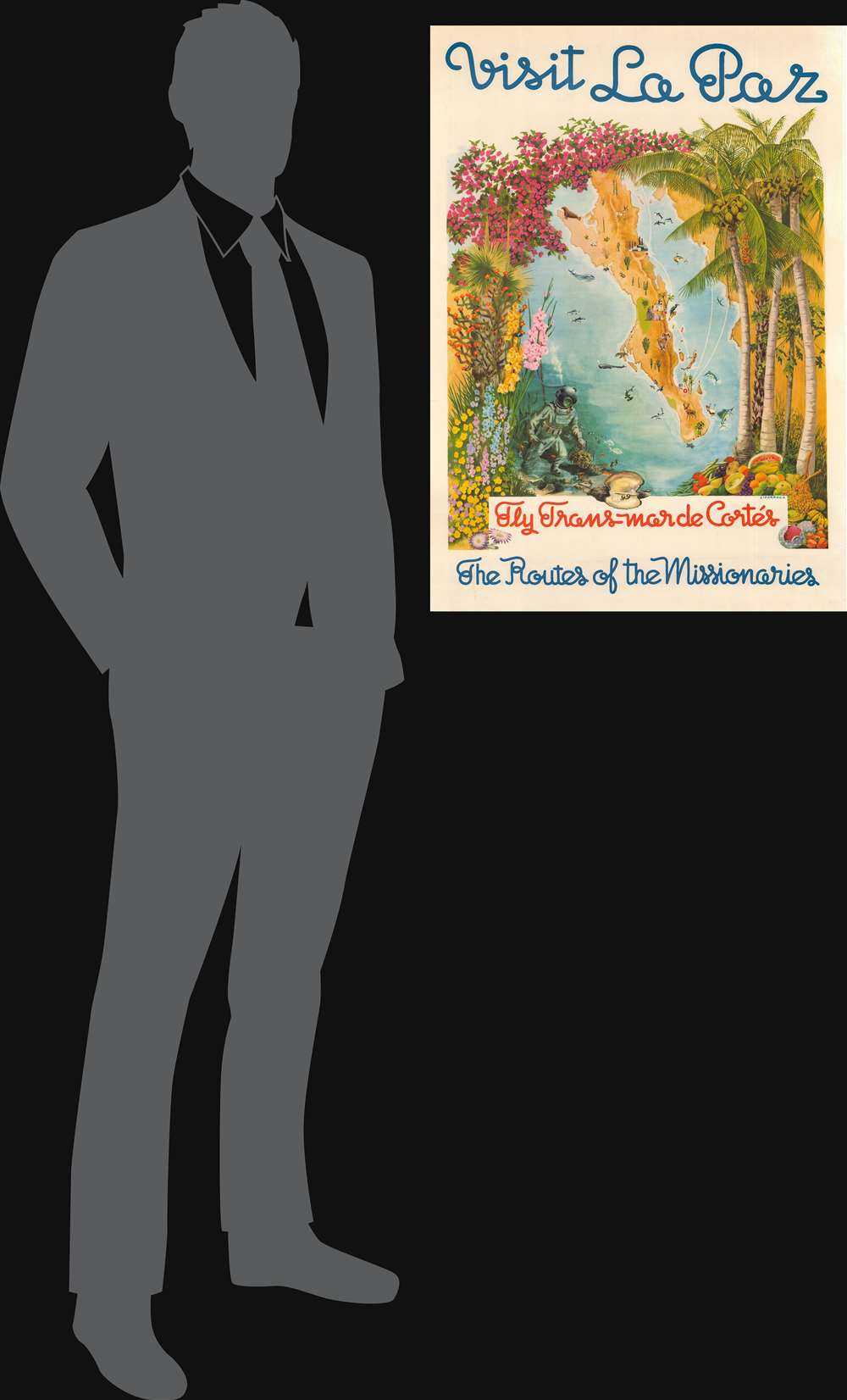1950 Lizarraga Advertisement, Trans Mar de Cortes, Baja California
LaPazBaja-lizarraga-1950$1,500.00

Title
Visit La Paz, Fly Trans Mar de Cortes, The Routes of the Missionaries.
1950 (undated) 30.5 x 21.5 in (77.47 x 54.61 cm)
1950 (undated) 30.5 x 21.5 in (77.47 x 54.61 cm)
Description
This is a beautiful c. 1950 map of Baja California, Mexico, advertises Trans Mar de Cortes Airlines. It promotes the peninsula's attractions, especially the city of La Paz, and repeats the airline's slogan that passengers will follow 'the routes of the missionaries.'
Further exploration and expansion northwards by missionaries (Jesuits then Franciscans) and military expeditions enlarged the borders of the Provincia de las Californias to the point that it was split in 1804 into Alta and Baja California. Soon afterward, Mexican independence divested the missions of their predominance and changed the Californias into territories.
In 1853, an American freebooter named William Walker tried to establish a 'Republic of Baja California and Sonora,' looking to emulate the success of Texas, but elicited little interest from either the U.S. or Mexican governments and the effort quickly fizzled out.
In the late 19th and 20th century, many expatriates were drawn to the peninsula for its natural beauty, affordability, and economic opportunities (some 100,000 Arabic-speakers from the Ottoman Empire settled in Mexico around the turn of the century). As the population of the U.S. state of California increased, Baja California came to be seen as an easy, nearby option for vacationers. Thus, the region's economy has relied on tourism as one of its primary industries for much of its modern history.
A Closer Look
La Paz is the capital and largest city of the Mexican state of Baja California Sur. The map also identifies Loreto, Santa Rosalía, San José del Cabo, and Cabo San Lucas. Decorative elements include illustrations of indigenous flora and fauna, fish, and a water-skier. Surrounding the map are various colorful depictions of flowers, palm trees, local produce and shellfish, and a scuba diver.Trans Mar de Cortes Airlines
Trans Mar de Cortes was founded in 1947 and began operations in 1948, capitalizing on the post-World War II (1939 - 1945) population boom in Southern California. The aesthetics of this lithograph and the company's slogan tap into Californians' 20th-century fascination with their state's Spanish colonial roots. In 1960, the airline was incorporated into Aeronaves de Mexico (Aeroméxico).Baja California
The first Spanish attempt to establish a colony on the Baja Peninsula was led by Hernan Cortes himself. However, this attempt failed due to a lack of food and general remoteness. After a failed attempt in 1683, a Jesuit mission was established in 1697, the first of many.Further exploration and expansion northwards by missionaries (Jesuits then Franciscans) and military expeditions enlarged the borders of the Provincia de las Californias to the point that it was split in 1804 into Alta and Baja California. Soon afterward, Mexican independence divested the missions of their predominance and changed the Californias into territories.
In 1853, an American freebooter named William Walker tried to establish a 'Republic of Baja California and Sonora,' looking to emulate the success of Texas, but elicited little interest from either the U.S. or Mexican governments and the effort quickly fizzled out.
In the late 19th and 20th century, many expatriates were drawn to the peninsula for its natural beauty, affordability, and economic opportunities (some 100,000 Arabic-speakers from the Ottoman Empire settled in Mexico around the turn of the century). As the population of the U.S. state of California increased, Baja California came to be seen as an easy, nearby option for vacationers. Thus, the region's economy has relied on tourism as one of its primary industries for much of its modern history.
Publication History and Census
This lithograph was drawn by an artist surnamed Lizarraga and was produced for the airline Trans Mar de Cortes around the year 1950. No other information about it is available. It is not known to exist in any institutional collection nor have any history on the market.Condition
Very good.




